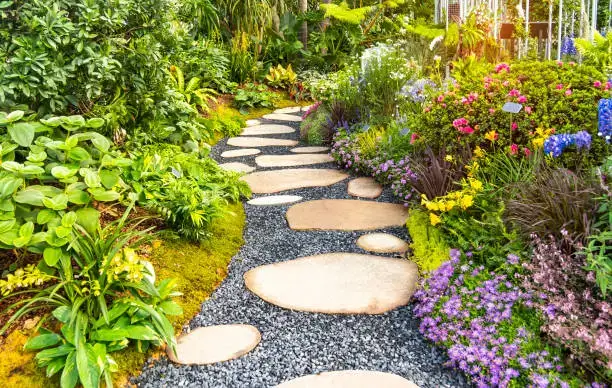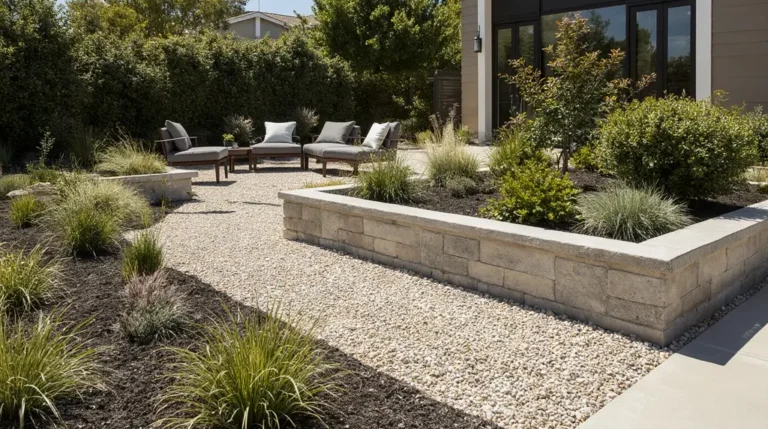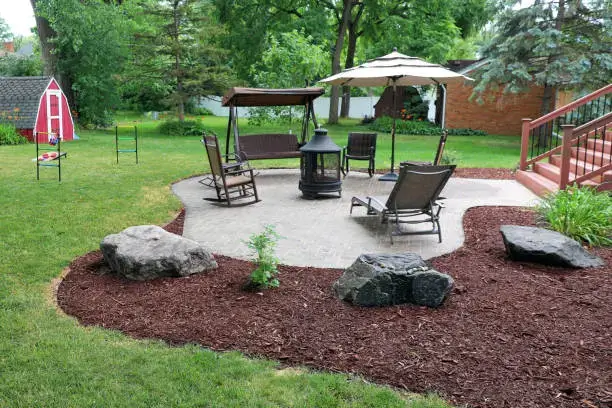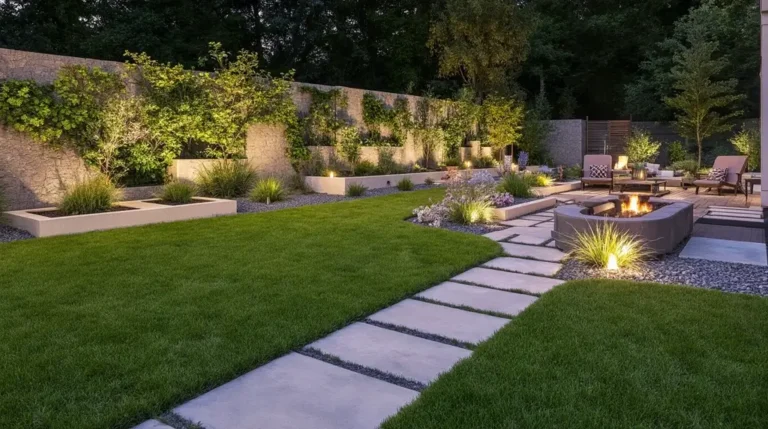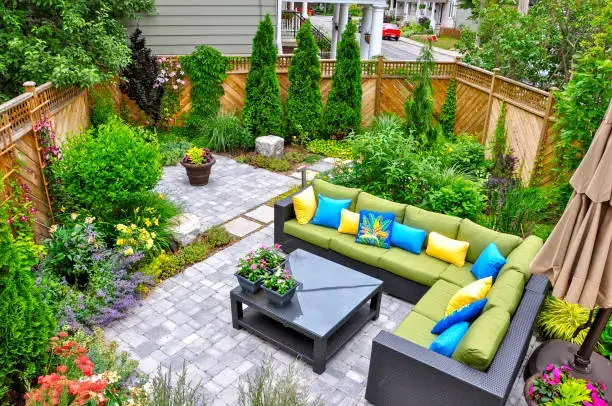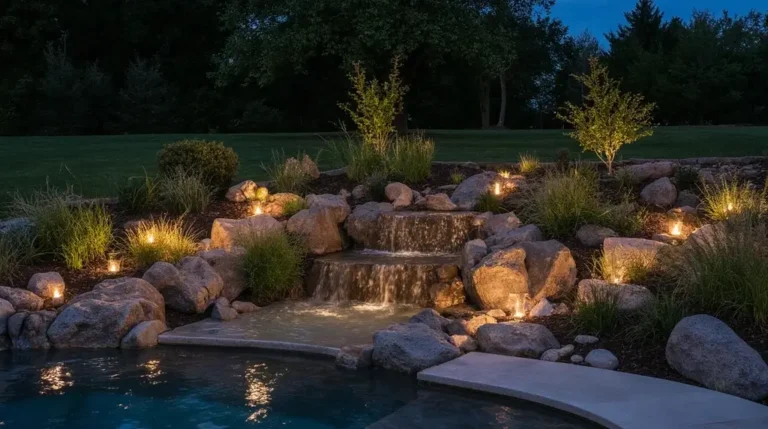Shade Garden Design: Best Plants and Layout Ideas Now
Table of Contents
Introduction: Turning Shady Spots into Tranquil Havens
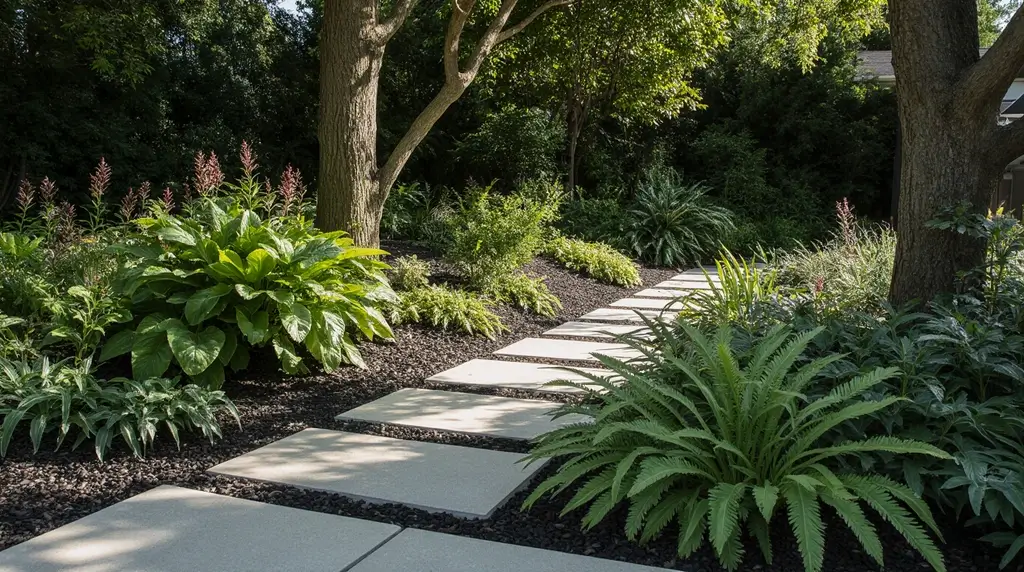
The Challenge and the Opportunity
Shade Garden Design
Every gardener knows the paradox of shade. On sweltering summer afternoons, those cool, shadowy corners of your yard become precious refuges from the heat. Yet when it comes to planting and design, these same spaces often become sources of frustration. Bare patches develop under trees. Plants struggle and fail. The vision of a lush, vibrant garden feels impossibly out of reach. Complete your dream garden with our handpicked Garden Design & Landscaping essentials that make outdoor spaces stylish and practical. get more info about Front Yard Landscaping Ideas to Boost Your Home’s Curb;
But here’s the truth that transforms everything: shade isn’t a limitation—it’s an invitation. A well-designed shade garden offers opportunities that sun-drenched spaces simply cannot match. The cooler microclimate, the reduced water needs, and the unique palette of shade-loving plants create possibilities for serene, low-maintenance landscapes that thrive where others see only problems.
Why This Guide Surpasses the Rest
This comprehensive guide draws on the expertise of award-winning garden designer Lee Burkhill, known professionally as Garden Ninja and recognized as a BBC presenter. Combined with detailed horticultural knowledge about shade plant biology and professional design principles, this resource provides actionable strategies that work in real gardens—not just in theory.
Whether you’re dealing with the dense canopy of mature maples, the challenging dry shade beneath evergreens, or simply the north-facing wall of your home, this guide translates professional expertise into practical steps you can implement immediately.
Content Goal
My mission is simple: to help you succeed in your shade garden, regardless of size. Whether you’re working with a sprawling backyard design project or transforming a tiny urban courtyard, you’ll find easy-to-digest advice that produces real results. Let’s turn those challenging shady spots into garden highlights you’ll actually want to spend time in.
Understanding Your Shady Garden: Light and Soil Assessment

Types of Shade Defined
Effective shade garden design begins with accurately identifying your shade type. Not all shade is created equal, and matching plants to specific light conditions makes the difference between thriving specimens and disappointing failures.
Dappled Shade (Part Shade): This filtered light typically occurs under deciduous trees or open shrubs, where sunlight dances through leaves and branches throughout the day. The shifting patterns of light and shadow create the most versatile growing conditions, allowing for maximum plant flexibility. Many shade garden plants actually prefer this environment over deep shade.
Partial Shade (Part Sun): Areas receiving 4-6 hours of direct sunlight—often morning sun from an eastern exposure—fall into this category. The cooler morning rays are gentler than afternoon sun, making these spots ideal for plants that need some direct light but can’t handle full-day exposure.
Deep/Full Shade: When shade persists all day with only indirect, ambient light reaching the ground, you’re dealing with deep shade. Common locations include the north side of buildings or beneath dense tree canopies like maples and sycamores. These areas require specialized shade garden plants that have evolved to photosynthesize efficiently in low-light conditions.
Dry Shade: Perhaps the most challenging condition, dry shade occurs under mature trees—particularly conifers like white pines or Norway spruces—where dense root systems compete aggressively for soil moisture. This combination of shade and drought stress limits plant options significantly.
Site Evaluation Steps
Success in shade landscaping ideas starts with knowing your specific growing conditions intimately. Here’s how to assess your space properly:
Track the Light: Spend a full day observing your shady area. Note the hours of direct sun versus shade, paying attention to how patterns shift from morning to evening. Take photos at different times to document these changes. Remember that seasonal variations matter—deciduous trees create different conditions in spring versus summer.
Identify Shade Sources: Understanding what creates your shade informs design decisions. Is it a building that blocks light permanently? A tree that drops leaves seasonally? A fence or pergola structure? Each source creates different growing conditions and opportunities.
Assess Soil Quality: Dig down 6-8 inches in several spots. Is the soil loamy and rich with organic matter? Heavy with clay that retains moisture? Sandy and porous, draining quickly? Soil quality dramatically influences which shade garden plants will thrive. Also note moisture levels—is the soil consistently damp, occasionally dry, or persistently parched?
Advanced Shade Garden Design Techniques
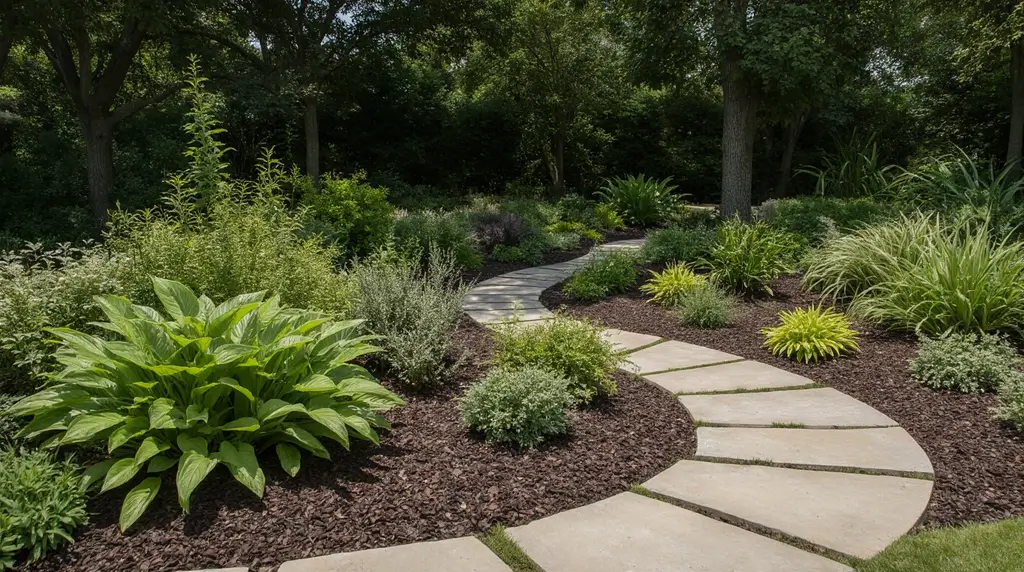
Brightening Dark Spaces with Foliage and Color
One of the most powerful shade landscaping ideas involves strategic color selection to manipulate how light behaves in your space.
Leverage Light-Reflecting Colors: Plants with lighter or variegated foliage act as natural reflectors, bouncing available light around the garden. Chartreuse foliage, in particular, seems to glow in shade, creating focal points that draw the eye. White-variegated leaves, silver foliage, and golden-hued plants serve the same purpose, instantly lifting the visual weight of dark spaces.
This principle is crucial for shade garden design—dark foliage recedes and disappears in shadow, while light-colored leaves stand out dramatically. A chartreuse hosta or golden Hakone grass can transform a gloomy corner into a luminous feature.
Cool-Toned Illusion: Shade gardens naturally lend themselves to cool color palettes. Greens, blues, and purples create an illusion of coolness and tranquility that feels especially refreshing during hot weather. These colors also appear to recede visually, making small spaces feel larger and more expansive.
Foliage Powerhouses: In shade, flowers are fleeting bonuses, but foliage is forever. Build your design around reliable foliage plants like Hostas with their architectural leaves, Heucheras (Coral Bells) offering burgundy to chartreuse options, Japanese forest grass providing graceful movement, and Coleus delivering tropical intensity. These plants provide months of color without depending on blooms.
Texture and Layering Strategies
The Layered Tapestry: Nature’s woodland gardens grow in distinct layers, and your backyard design should mimic this structure. Start with trees and tall shrubs forming the canopy layer. Add mid-sized perennials at the understory level. Finish with groundcovers carpeting the forest floor. This layered approach creates depth, visual interest, and a naturalistic feel that simply looks right in shaded settings.
Textural Contrast: Juxtaposing different leaf textures prevents monotony and creates drama. Pair bold, architectural elements—like the broad, substantial leaves of large hostas—with fine, delicate textures such as lacy ferns or flowing Hakone grass. The contrast between these opposing textures creates visual tension that engages the eye and adds sophistication to your shade garden design.
Keep it Simple: Here’s a professional secret that many amateur gardeners miss: restraint creates impact. Rather than planting one of everything, use large drifts of the same plant—groupings of 3, 5, 7, or more. This repetition creates cohesive style and prevents the design from becoming visually chaotic. Stick to 1-4 different plant varieties in any given area for maximum effect.
Incorporating Structure and Hardscape
Structural Plants: Shade-loving shrubs provide year-round structure that perennials cannot match. Hydrangeas bring late-summer blooms and interesting winter forms. Rhododendrons offer evergreen presence and spectacular spring flowers. Small trees like Redbud (Cercis canadensis) provide height, spring color, and elegant branching structure.
Hardscape Features: Don’t overlook the power of non-living elements in your shade garden design. Pathways invite exploration and protect delicate plants from foot traffic. Seating areas encourage lingering and enjoying the cool respite. Containers add flexibility and height variation. Statuary creates focal points. Strategic lighting extends enjoyment into evening hours, revealing a completely different garden character after dark.
Top Shade-Loving Plant Recommendations

Perennials: The Shade Garden Workhorse
Hostas: If shade gardens had a mascot, it would be the hosta. These classic, hardy perennials offer unmatched reliability, providing structure and serving as the canvas upon which you paint your design. With hundreds of varieties offering diverse leaf patterns, colors, and textures, hostas never become boring.
For brightening purposes, seek variegated varieties: ‘Sum and Substance’ delivers massive chartreuse leaves that glow like beacons. ‘Sagae’ combines blue-green centers with golden margins for elegant contrast. ‘Echo the Sun’ offers butter-yellow foliage that illuminates the darkest corners. Hostas thrive in partial to deep shade and tolerate a wide range of soil conditions once established.
Dicentra (Bleeding Hearts): These graceful plants adapt to conditions from full sun to full shade, making them remarkably versatile. The traditional pink-flowered varieties offer romantic, heart-shaped blooms in spring, but the real star for shade garden design is ‘Gold Heart’ Dicentra. Its brilliant chartreuse foliage maintains color from spring through fall, providing months of luminous presence.
Heuchera (Coral Bells): Few shade garden plants offer such color diversity while maintaining compact, tidy growth habits. Heucheras provide visual interest even without flowers, though their delicate blooms on tall stems add bonus color. Foliage ranges from chartreuse (‘Key Lime Pie’) to silver (‘Palace Purple’) to deep burgundy (‘Obsidian’).
Northern Exposure™ Amber glows with peachy-orange tones, while Ruby Tuesday delivers deep wine-red leaves. These plants thrive in conditions from full sun to full shade, making them incredibly adaptable workhorses for shade landscaping ideas.
Hellebores (Lenten Rose): For winter interest and early spring flowers, few plants rival hellebores. These evergreen perennials produce elegant, cup-shaped flowers as early as March, often blooming through snow. The glossy foliage remains attractive year-round, and plants self-sow to create natural drifts over time. Hellebores handle dry shade better than most perennials and ask for virtually no maintenance once established.
Astilbe (False Spirea): Deep shade lovers that add vertical interest with their fluffy flower spires, astilbes bring summer color in shades of pink, red, white, and peach. They tolerate early morning sun but truly excel in shade, particularly in moist soil conditions. The ferny foliage provides attractive texture even after flowers fade.
Annuals: For Constant Color Power
Begonias: Having evolved in tropical rainforest understories, begonias are genetically programmed to thrive in warm, moist, shady conditions. They deliver intense, continuous color from late spring until frost, making them invaluable for shade garden plants that need to perform all season.
Dragon Wing Begonias offer large, angel-wing leaves and continuous red or pink flowers. Tuberous Begonias provide spectacular, rose-like blooms in vibrant colors. Tectonic™ Begonias combine bronze foliage with bright flowers for dramatic contrast. All tolerate deep shade while maintaining robust flowering.
Impatiens: Another tropical native, traditional impatiens thrive in shady, humid environments, tolerating everything from morning sun to full shade. Their prolific flowering and self-cleaning habit (no deadheading required) make them ideal for low-maintenance color. Choose from countless colors to complement your design scheme.
Sunpatiens: A breakthrough in breeding, Sunpatiens combine impatiens’ shade tolerance with unprecedented sun tolerance and disease resistance. These vigorous plants resist the downy mildew that plagues traditional impatiens, producing larger flowers on more robust plants. Despite their name, they excel in full shade as well as sun, offering remarkable versatility.
Shrubs and Grasses: For Structure and Movement
Hakone Grass (Hakonechloa macra): This graceful Japanese native adds flowing texture and gentle movement to shade gardens. Unlike most ornamental grasses that demand full sun, Hakone grass actually prefers shade, where its cascading form seems to flow like water.
‘All Gold’ lights up shady corners with bright golden-yellow foliage, while ‘Aureola’ features green and gold striping for a more subtle effect. Both turn peachy-orange in fall before going dormant. Use Hakone grass to soften hard edges, fill containers, or create sweeps of movement in your backyard design.
Japanese Laurel (Sunny Daze®): For the shadiest situations where even hostas struggle, Japanese Laurel delivers. This evergreen shrub features unique variegated foliage—each leaf splashed with gold—that brightens dim spaces year-round. Slow-growing and compact, it requires minimal maintenance while providing consistent presence through all seasons.
Practical Care and Maintenance Tips for Shade
Hydration Balance
A common misconception holds that shade gardens need constant watering. In reality, shade gardens generally require less water than sunny spaces because evaporation occurs more slowly. Before watering, always check soil moisture by inserting your finger 2-3 inches deep. Only water when the soil feels dry at that depth.
The exception involves dry shade under large trees. In these locations, aggressive root systems compete for every drop of moisture, potentially requiring more frequent watering during extended dry spells. Consider installing soaker hoses or drip irrigation for consistent moisture delivery without wasteful evaporation.
Soil and Nutrients
Preparation determines success. Before planting shade garden plants, amend the soil with 2-4 inches of compost or aged organic matter. Woodland plants evolved in forest soils rich with decomposed leaves and prefer well-draining, slightly acidic conditions.
Fertility requirements in shade are modest. Because plant metabolic demands decrease with reduced light levels, shade gardens need significantly less fertilizer than sunny borders. A spring side-dressing of compost often provides sufficient nutrients for the entire season. If supplementing with fertilizer, feed every 3-4 weeks rather than weekly, using half the recommended rate.
Pest and Weed Management
Apply 2-3 inches of organic mulch to maintain soil moisture and suppress weed germination. Shredded bark, composted leaves, or aged wood chips all work well. Maintain a mulch-free zone immediately around plant stems to prevent rot.
Slugs and snails frequently target shade garden plants, particularly hostas with their succulent foliage. Organic control methods include beer traps, copper barriers, diatomaceous earth, or iron phosphate baits (safe for pets and wildlife). Hand-picking in early morning or evening, when these pests are active, also provides effective control.
Beyond the Blog: Further Resources and Expert Support
Explore Related Guides
This article represents just one facet of comprehensive garden knowledge. Explore hundreds of additional articles covering every aspect of garden design, from wildlife gardens that support pollinators to lawn care strategies that reduce maintenance. Beginning gardeners will find detailed guides on growing your own fruit and vegetables, while experienced gardeners can dive into advanced design theory and plant combinations.
Visual Learning
Sometimes seeing is believing. Watch hundreds of YouTube tutorials demonstrating these shade garden design principles in real gardens. Video guides show exactly how to assess shade levels, prepare soil, arrange plants for maximum impact, and maintain your shade garden through the seasons. These vlogs bring theory into practice, showing techniques in action.
Get Personalized Advice
Every garden presents unique challenges. Join our online gardening forum where hundreds of experienced Garden Ninjas stand ready to answer your specific questions. Whether you’re troubleshooting a struggling plant, designing a complete landscape, or simply seeking plant recommendations for unusual conditions, community expertise provides solutions.
Downloadable Tools
Access free resources to jump-start your shade garden project. Download landscape planning templates, planting schedules, maintenance checklists, and design worksheets. Sign up for our newsletter to receive the latest guides, seasonal tips, and exclusive discounts on recommended products delivered directly to your inbox.
Final Thoughts
Creating a successful shade garden design transforms challenging spaces into tranquil retreats that offer respite during hot weather while requiring less maintenance than traditional sunny borders. By understanding your specific shade conditions, selecting appropriate shade garden plants, and implementing professional design techniques, you’ll create landscapes that thrive in low-light conditions.
Remember that shade gardening offers unique advantages: reduced water needs, lower maintenance requirements, and access to a fascinating palette of plants unavailable to sun gardeners. Those shady corners aren’t problems to solve—they’re opportunities to explore a different, equally rewarding approach to gardening.
Start small, observe how plants perform in your specific conditions, and adjust your design as you learn what thrives in your unique microclimate. With patience and the right knowledge, your shade garden will become a highlight of your landscape—a cool, serene sanctuary that showcases the beauty possible when you work with nature rather than against it.
Shade Garden Design: Best Plants and Layout Ideas Now
Every gardener knows the paradox of shade. On sweltering summer afternoons, those cool, shadowy corners of your yard become precious refuges from the heat. Yet when it comes to planting and design, these same spaces often become sources of frustration. Bare patches develop under trees. Plants struggle and fail. The vision of a lush, vibrant garden feels impossibly out of reach. Complete your dream garden with our handpicked Garden Design & Landscaping essentials that make outdoor spaces stylish and practical. get more info about Front Yard Landscaping Ideas to Boost Your Home’s Curb;

